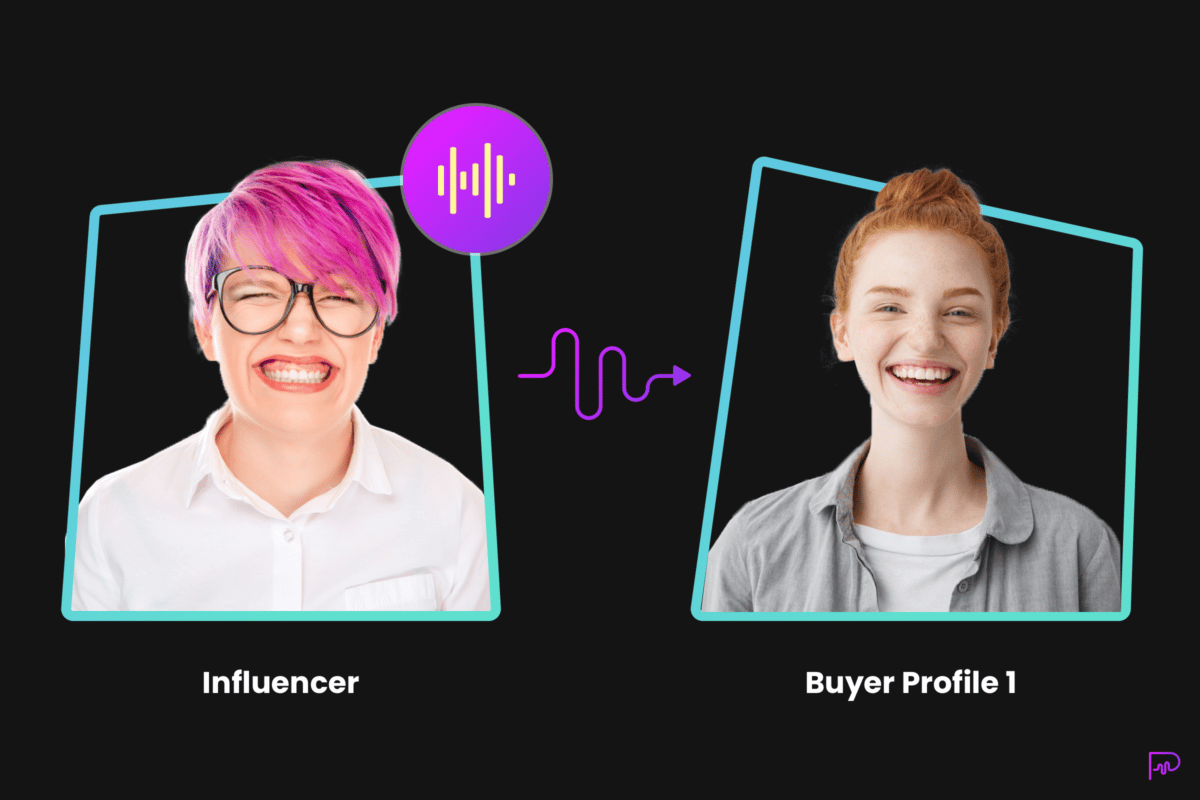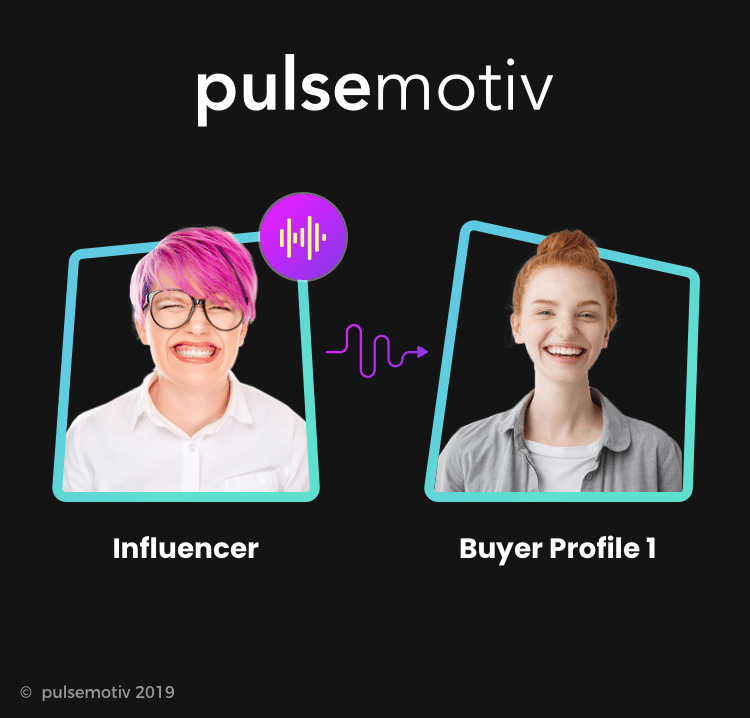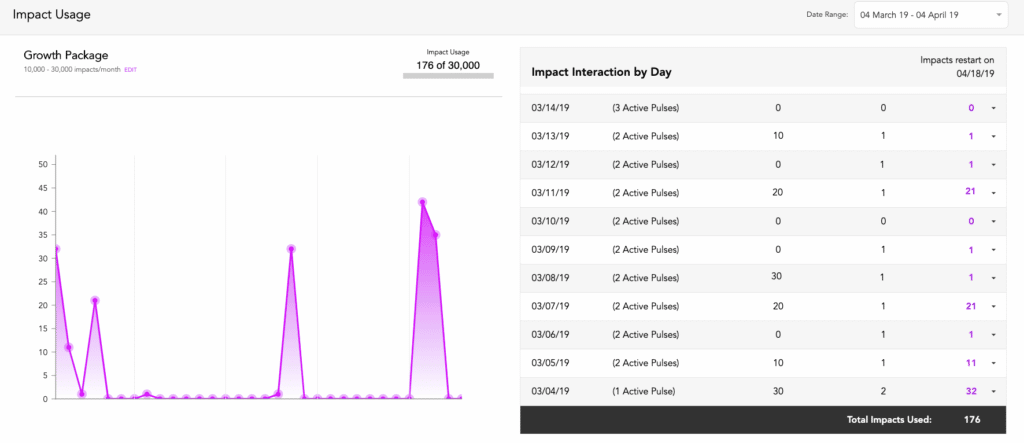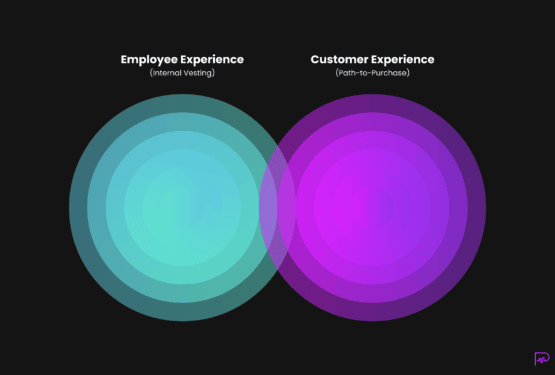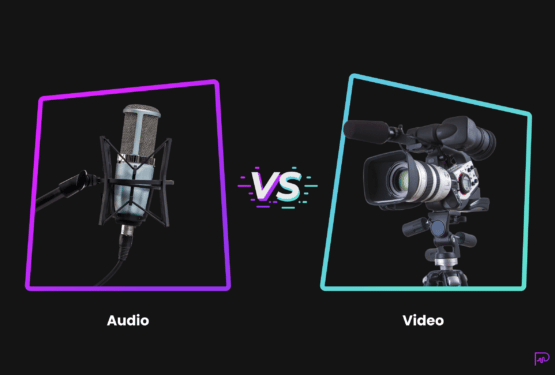When it comes to mastering the ins and outs of conversational guidance, having a roadmap probably seems pretty unnecessary. After all, we engage in conversation every day. Whether you’re talking to your family over dinner or chatting around the water cooler with a colleague, conversation is the crux of human connection and good communication.
But the action of speaking is not what’s key here. Listening skills are a core part of being a good communicator. The challenge we’re facing today is that the nature of the web has made it difficult to listen in the digital space the same way we are able to listen in a face-to-face dialogue. Because of the inability to listen with intention, consumers have been left to bear the burden of listening to businesses amplify their message every chance they get. Until now.

Conversational guidance is the new path toward turning websites into a two-way street. Instead of a megaphone booming with marketing messages, you can feel a brand’s authenticity when they’re speaking with you in a conversational format. It’s just as though you’re in the room with them, speaking face-to-face, but you know you can’t be… So what we do is make it feel like a conversation as we guide them through their journey. Coupled with our intelligent analytics dashboard you’ll know exactly what your customers are thinking and doing as they’re engaging with your audio. It’s a strategy that’s caught fire and for good reason.
What’s the Big Deal About Conversational Guidance Anyway?
Conversations have been around longer than formal human language. When cavemen were still grunting their way through the savannah as they fought to bring home fresh meat to their families, they found a way to exchange vital information.
We’re centuries beyond those times, but the concept remains the same. As humans, we still exchange ideas and thoughts to help each other get through this thing called life. That’s conversation.
Marketers have since taken the concept of creating a back-and-forth between people and applied it in order to humanize buying experiences. Consider a few familiar examples of conversational guidance we see in the physical world today.

When you’re walking into an Apple store, you’ll likely be met by a team of “geniuses.” These people are well-trained to humanize the buying experience by showing empathy and conversing with you on a personal level.
And Apple is not the only brand who offers this type of personalized experience. Starbucks does too.

Even at a store as busy as the Starbucks in Time Square (pictured above), baristas are expected to remember customer names. You’ve probably had a similar experience when you walked into a Starbucks and had a cheery barista ask your name, which of course helps them get you the proper order, but that’s not the only reason. They want to make the experience feel more like you’ve walked into a friend’s house by being able to refer to you by name when you come in again.
Until recently, the challenge for companies who operate digitally has been to create this same atmosphere. But how do you welcome someone into a digital space and use human touch to make the overall experience more inviting? To do that, many brands are using tools to replicate in-person conversations on their website. Chatbots and videos are one example of the way brands are offering a more personal element on their web pages. Then again, these methods can do more harm than good if mishandled. Take a look at this example of a superior chat experience vs. a failed one.
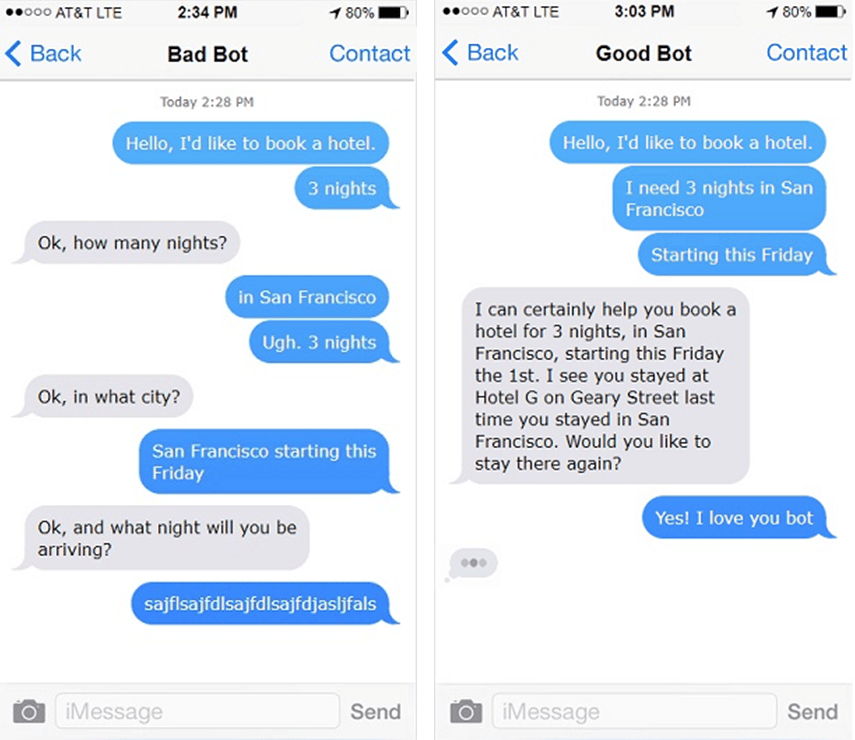
Source: Casey Phillips
Creating the Conversational Vibe
As someone tasked with growth, you’re probably thinking by now that this marketing method makes sense in theory, but what does it look like in action? Sure, conversing in digital spaces is relatively new, but the concept isn’t. To prove that point, come with us as we drill down to what it looks like as you make your business feel more approachable online.
But before we take that gradual descent into the nitty gritty of personalized experience through conversational guidance, let’s look at the 10,000 foot view.
It’s easy to deliver.
Because you’re human, you were naturally born a conversationalist. No, you may not be the poster child of extrovertedness who enjoys public speeches and has never failed to deliver a witty retort… But conversation and communication in all its forms, and all its uses, are built into our day-to-day modus operandi. We communicate in so many ways, so many times a day, at nearly every interaction with the world around us.
These are the human skills you’ll need when it comes to setting up a conversational strategy in your business. With a little web audio technology it’s easy to bake that conversational vibe into your website, but you already have the necessary skills needed to leverage your human voice to make a bigger impact among your buyers.
It’s easy to design.
Recording and conversing is one thing. Getting your website visitors to engage and hear the sound of your voice is another. That’s where having the right design comes into play.
Fortunately, many apps have considered the importance of design when building the types of products that bring a conversational vibe to your website. Just take a look at the sleek design of Pulsemotiv as evidence.
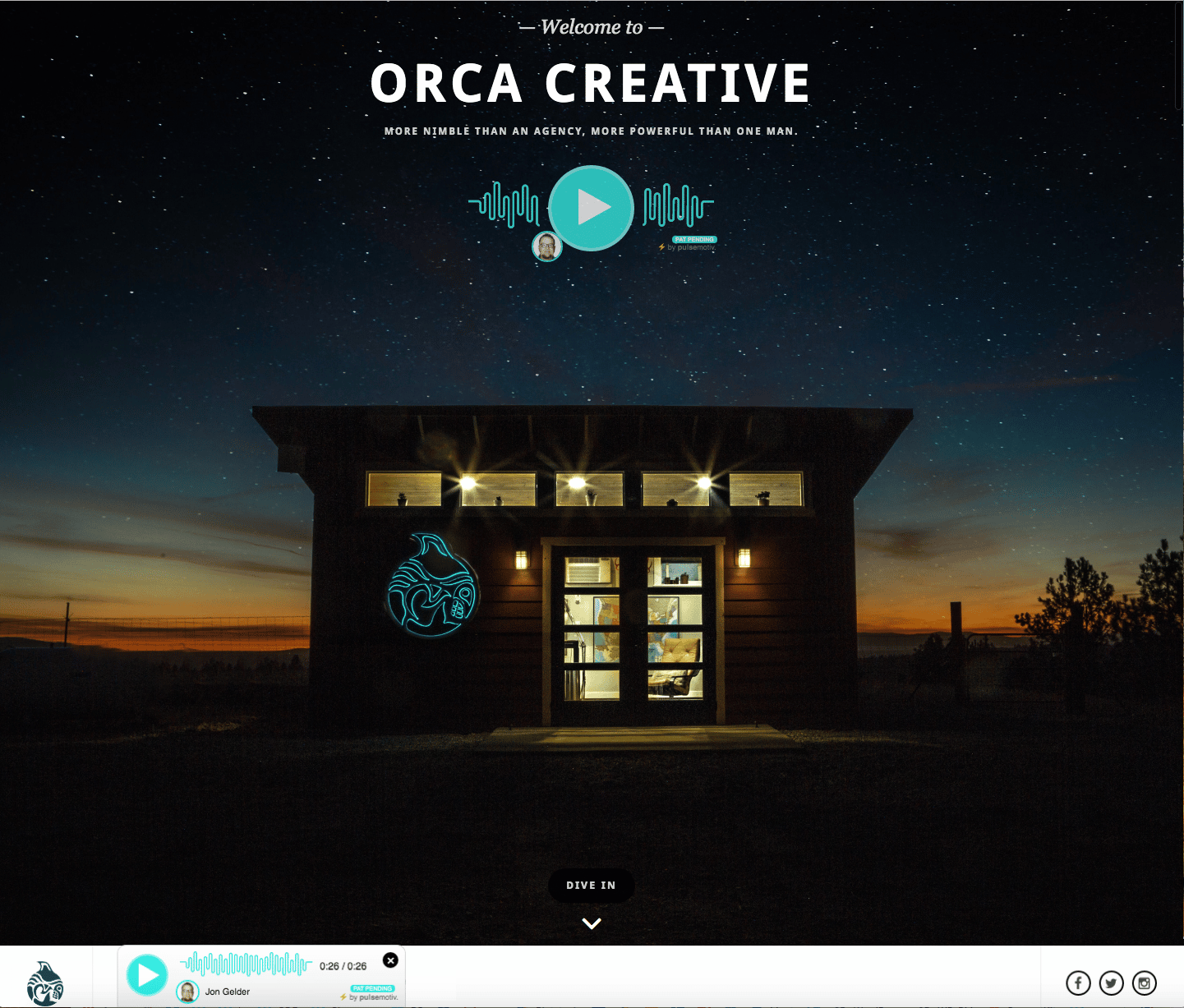
This design can easily be tweaked to fit a wide spectrum of companies, brand colors, and design aesthetics. Want to see it in action? Head over to the Pulsemotiv homepage to take it for a spin and see what Pulsemotiv looks like in your brand’s colors. This concept of branding the tool for your website is important because it creates a seamless experience for the end user. When deployed, the user’s eyes are drawn to click on the pulsating play button to hear from you.
It’s easy to deploy.
Once you have your audio recorded and design polished to compliment your brand, all that’s left is deploying it on your website. There are a number of ways to make this happen. Pulsemotiv does all the heavy lifting for you and simplifies the process down to copying and pasting an embed code. Or, if you like, download the plug-in for WordPress to access your pulses from a drop down menu directly inside your WordPress account. No matter how it’s installed, most of the time, deploying the technology is pretty darn easy.
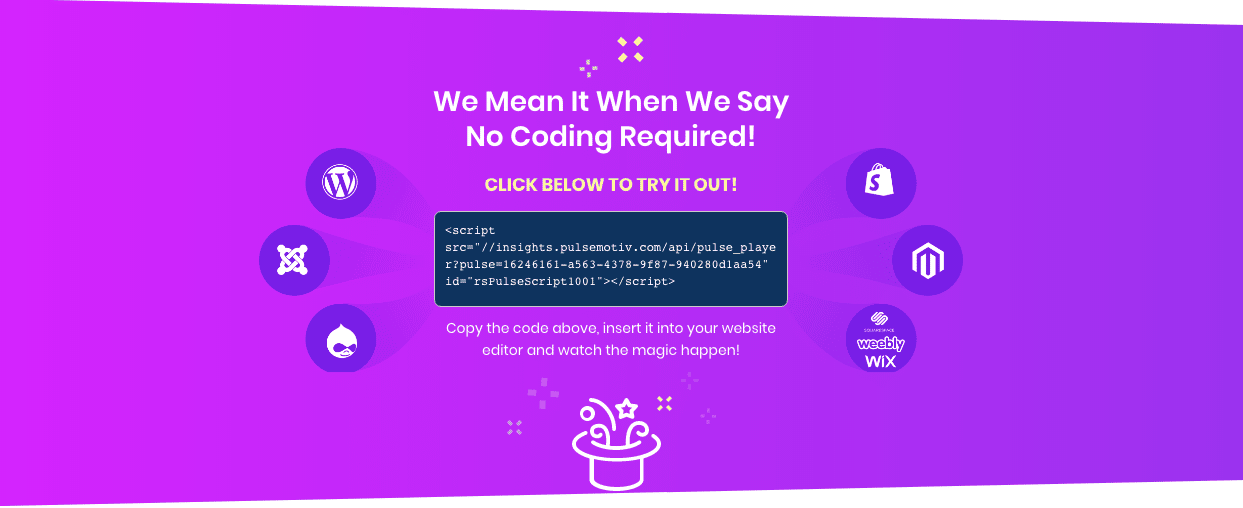
With such a short learning curve, it’s a better time than ever to jump on the conversation tidal wave. Still, to be able to best ride that wave, it never hurts to have a roadmap to start sketching out your plan of action.
Step 1: Plan Your Goals
Before you begin any marketing initiative, you must get crystal clear about your goals. For example:
- Do you want to see more conversions on your sales pages?
- Do you want to lower your customer effort scores?
- Do you want to increase your net promoter score and get more people into your funnel?
By clearly defining your goals, you’ll simultaneously define what your wins will look like. It’s an imperative step to define your milestones in order to define what success looks like. From there, you can drill down and get more granular about what will need to happen in order for you to reach those high-level goals.
As you set your ambitious future objectives, don’t forget to celebrate small wins along the way too. Defining what the smaller wins will look like upfront can ease the inevitable feelings of overwhelm involved in pursuing lofty goals, and will make your initiatives look more realistic and feel more achievable. So, when you’re starting out, it’s important to look at the big picture without overlooking the minor milestones along the way to build momentum as you dive into something new.
Step 2: Map the Journey
With clear goals in mind, the next step is to map out what path to take to guide your users from one point in their journey to another. This approach is called journey mapping.
There are a host of ways to go about mapping out the journey you want your buyer to take. As you gather your team, it might feel as if everyone has a different concept of what needs to happen and how to achieve those end goals. Instead of elbowing each other out of the way to get your voice heard, we suggest taking a different approach.
Gain consensus on who to target first.
Sure, you might have a general idea of which cohorts you want to engage, but in order to map an effective journey led by conversation you’ll need to get more granular than that. Look specifically at where you can reach prospects or users who are serious about buying and/or learning from you. By only reaching out to serious buyers, you can get a better gauge of intent, effectiveness of your messaging, and reach your goals faster.
Get empathetic to your buyer’s journey.
There are numerous touchpoints within your buyer’s journey where you can reach out and chat with your customers. Think from the user’s perspective, where in the process would you want someone to step in and lend a hand? These are likely the areas that will yield the best results when a humanized element is added to the experience.
Then, develop the path you want them to take to reach the end goal that suits their needs but also aligns with your big picture goals.
For example, if you’re using conversational guidance to drive more sales, start with the pricing page and then guide your prospects through the purchase. Or, if you’re hoping to improve the onboarding experience, leverage user guidance to showcase the product in action in the key areas where you most need to get buy-in to develop loyal users.
As you’re doing this, focus your approach to one type of buyer at a time instead of trying to target all cohorts with one lengthy journey. It’s better to develop many journeys with specific unique detail than one that remains to broad to be useful. Continuing to develop experiences that feel personal for the customers you’re aiming to reach, based on insights garnered through journey mapping, will help you get specific with your messaging and see bigger results in turn.
Step 3: Create a Vision Board
With your journey mapped, it’s time to put everything on display for you and your team to see. Proper visualization is key to keeping your whole team on the same page, and keep the plan on top of mind. In creating a vision board of how the conversational strategy will play out, divide up the aspects of the buyer’s journey that you want to focus on, identify what’s needed within each area to drive growth, and keep the most important elements central.
Remember that as you do this, you’re not pulling out the chisel to set these details in stone. In today’s ever-evolving digital world, adapting to unexpected changes is critical. Your vision board will lay out your course, but flexibility will help you navigate any necessary shifts as they arise by being intelligent and empathetic about your customer’s journey.
Step 4: Write the Scripts
Enough talk! Enough planning! You’re ready for action! Time to leverage all that high level stuff to create some powerfully engaging content.
The first step in this approach is to outline what needs to be said and how you’ll say it.
Scripting your pulses shouldn’t take a lot of time. In fact, the less time it takes, probably the better. Why? Because conversation isn’t overly scripted.
Conversations aren’t stiffly scripted. Your conversational guidance strategy shouldn’t be either.
Although it’s tempting to read from a structured speech, avoid writing out what you’ll say word-for-word. By working off of an outline, laying out the bullet points for how you’ll talk your customers through your website, you can make your conversation sound more natural and trustworthy, without missing any important points.
Step 5: Hit Record
Do you cringe a little bit when you hit record? Most people do. Few people are lucky enough to relish in the sound of their own voice (looking at you Samuel L. Jackson).
<iframe src=”https://giphy.com/embed/o8VXwSvuLXhM4″ width=”480″ height=”269″ frameBorder=”0″ class=”giphy-embed” allowFullScreen></iframe><p><a href=”https://giphy.com/gifs/ew-disgusted-parks-and-rec-o8VXwSvuLXhM4″>via GIPHY</a></p>
It’s a natural reaction when you hear your own voice playing back to you, and for most people the idea of recording can feel a little daunting. But here’s the catch. You’re probably the only one in the world who cringes at the sound of your voice. For most other people online, the sound of your voice piping through their speakers is comforting, engaging, and a welcome surprise. Your customers want to hear your voice.
The other challenge of recording web audio is knowing which technology to use to make you sound clear, professional, and polished. We wrote a post about just that, so I won’t reiterate it here. If you’re looking for a nice setup, squirrel this post away on how to record and deploy web audio.
Step 6: Upload, Publish, Then Hold Your Breath
Phew! The audio is recorded and you absolutely killed it. Now it’s time to get this baby on your website. This is the moment you’ve been waiting for with much anticipation.
Where you place your audio snippets matters. Remember, you’re here to guide your customers to action, which means you need to be sure your audio is visible, in just the right place at the right time on the website. Pop-up ads are annoying. By placing your audio player in a spot that contributes to the overarching experience, you can be sure your visitors hear you at the perfect moment in their journey with you.
Then, once it’s on your website, you play the hardest game of all — the waiting game. Hold your breath and wait to gather a large enough sample size to give you conclusive data about what’s working in your conversational guidance strategy. When the data is in, you’re ready to move to the final step.
Step 7: Analyze the Results
This last step is arguably one of the most critical steps in the entire strategy — analyzing your audio. Without analytics, you won’t know whether it’s working or how close you’re getting to your end goal.
One of the most common user engagement problems is breaking data out of their cozy little silos and ensuring it’s clean. This requires you to set up some parameters about which data points you’re tracking and how you’re getting the analytics you need to know if your strategy is a success.
In choosing which data to track, think back to step 1. What were your big picture goals? What were your smaller goals? What you track will vary depending on what you call successful but here are some core ideas to get you started:
- Bounce rates. If people are bouncing, they’re not responding to your conversation. You’re having a monologue on your website instead of a dialogue.
- Conversion rates. Whether a conversion means a new email sign up or a sale, tracking those conversions can help you know how quickly you’re growing.
- Pulse score. Your pulse score takes a variety of data points into account including the length of plays on your audio and the number of clicks on your slide outs. Each is a measure of how a visitor reacted to your message, which is their way of responding to you and building that two-way street.
Now, Over to You
We’ve laid out the necessary steps that you must take to deploy an effective conversational guidance roadmap. Now, it’s up to you to determine where you’ll step in and guide your visitors to create an environment of active engagement and how you’ll put this approach into action across your business.
Ready to get started? We’re ready to see what you’ll create! Start your free 14-day trial and let pulsemotiv be your conversational guidance engine.

